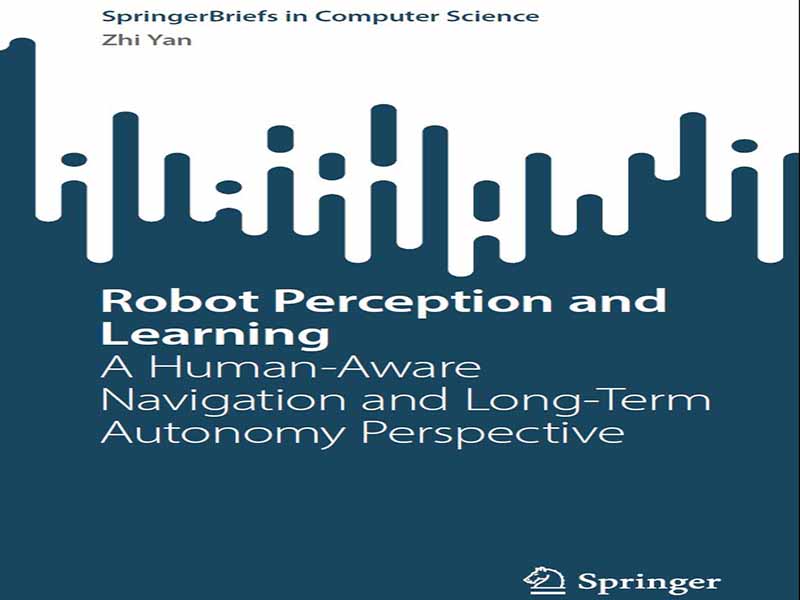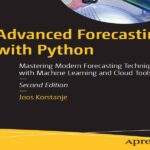- عنوان کتاب: Robot Perception and Learning -A Human-Aware Navigation and Long-Term Autonomy Perspective
- نویسنده: Zhi Yan
- حوزه: یادگیری ربات
- سال انتشار: 2025
- تعداد صفحه: 113
- زبان اصلی: انگلیسی
- نوع فایل: pdf
- حجم فایل: 2.43 مگابایت
در سال ۲۰۱۵، از دکتر نیکولا بلوتو وظیفهای دریافت کردم تا به یک ربات نظافتچی حرفهای اجازه دهم نقاطی را که نشاندهنده انسانها در ابر نقاط تولید شده توسط لیدار سهبعدی هستند، شناسایی کند. سپس، بر اساس پیشرفت تحقیقات در آن زمان، یک ابزار حاشیهنویسی ابر نقاط توسعه دادم، دادههای ابر نقاط را جمعآوری کردم، هزاران فریم ابر نقاط را به صورت دستی حاشیهنویسی کردم و سپس یک مدل SVM را آموزش دادم، با ربات آزمایش کردم، پارامترهای آموزشی را تنظیم کردم و دوباره مدل را آموزش دادم. سپس ناگهان ربات محیط استقرار خود را تغییر داد و من مجبور شدم دوباره دادهها را جمعآوری کنم و آنها را بارها و بارها حاشیهنویسی کنم. بعداً، در قبرس، از نیکولا شکایت کردم که چرا ربات نمیتواند این ابرهای نقطهای خستهکننده را خودش یاد بگیرد؟ پس از بازگشت به لینکلن، دکتر تام داکت به بحث پیوست و سرانجام در ژوئیه ۲۰۱۶، پیشنویس اولین مقاله «یادگیری آنلاین ربات» خود را با هم تکمیل کردیم. از سال ۲۰۱۵، درک و یادگیری ربات خط اصلی تحقیقات من بوده است. ده سال بعد، نتایج تحقیقات خودم و تحقیقاتی که تحت نظارت من انجام شد، در موسسه پلیتکنیک پاریس مورد تقدیر قرار گرفت و سرانجام توانستم مدرک Habilitation à Diriger des Recherches را در فرانسه دریافت کنم. برای این منظور، لازم بود پایاننامهای تهیه کنم تا تحقیقاتم را از زمان دفاع دکترایم به طور سیستماتیک خلاصه کنم. این منجر به نوشتن این کتاب شد.
جستجوی رباتهای واقعاً هوشمند که قادر به عملکرد مؤثر در محیطهای پیچیده و بدون ساختار باشند، پیشرفتهای چشمگیری را در ادراک و یادگیری به همراه داشته است. در حالی که رباتیک سنتی اغلب به دستورالعملهای از پیش برنامهریزی شده و محیطهای مهندسی شده دقیق متکی بود، تقاضای روزافزون برای رباتهای متحرکی که میتوانند با محیط و تجربیات خود سازگار شوند، تعامل داشته باشند و از آن یاد بگیرند، این حوزه را به سمت هوش تجسمی سوق داده است. این الگو بر نقش حیاتی تجسم فیزیکی در شکلدهی ادراک، عمل و شناخت تأکید میکند و منجر به سیستمهای رباتیک قویتر و سازگارتر میشود. هدف این کتاب ارائه مروری بر آخرین تحقیقات در تقاطع این حوزههای حیاتی، با تمرکز ویژه بر ادراک سهبعدی مبتنی بر لیدار و روشهای یادگیری آنلاین ربات، با وظایف پاییندستی شامل ناوبری ربات آگاه از انسان و استقلال بلندمدت ربات است. ساختار آن به شرح زیر است: فصل 1 پیشینه تحقیق، موقعیتیابی محتوا و برخی منابع منبع باز مرتبط را معرفی میکند. فصل 2 برخی از مسائل معیار مربوط به حوزه هوش تجسمی و رباتیک سیار را مورد بحث قرار میدهد. فصل 3 ادراک ربات، به ویژه تشخیص و ردیابی اشیاء مبتنی بر لیدار سهبعدی با ویژگیهای معاصر را معرفی میکند. فصل 4 یادگیری ربات، به ویژه روشهای یادگیری آنلاین ربات با ویژگیهای قوی هوش تجسمی را معرفی میکند. فصل 5 کتاب را خلاصه میکند و چشماندازهایی را برای تحقیقات آینده و جهتگیریهای کاربردی ارائه میدهد.
این کتاب برای محققان و متخصصانی که از قبل با اصول رباتیک سیار آشنا هستند، از جمله دانشجویان تحصیلات تکمیلی، داوطلبان دکترا، محققان فوق دکترا و متخصصان صنعت که در زمینههای مرتبط کار میکنند، در نظر گرفته شده است. این کتاب یک کتاب درسی به معنای سنتی نیست؛ به مطالب مقدماتی اولیه نمیپردازد. در عوض، این کتاب بر ارائه روشها و اصول اصلی که تحقیقات پیشرفته را هدایت میکنند، تمرکز دارد و مروری ساختارمند بر مفاهیم کلیدی و پیشرفتهای اخیر ارائه میدهد. نتایج تجربی دقیق و جزئیات پیادهسازی خاص عمداً حذف شدهاند تا تمرکز بر مبانی نظری و روششناختی گستردهتر حفظ شود و خوانندگان را تشویق کند تا برای تحلیل عمیق و استراتژیهای پیادهسازی عملی به مقالات تحقیقاتی اصلی مراجعه کنند.
این کتاب بدون مشارکت محققان متعددی که کارشان پایه و اساس این حوزه را تشکیل میدهد، امکانپذیر نبود. ما از مشارکتهای ارزشمند آنها سپاسگزاریم و امیدواریم که این کتاب به عنوان منبعی مفید برای کسانی که به دنبال درک و مشارکت در آینده ادراک و یادگیری ربات هستند، عمل کند. همچنین از هر داوری که در مورد پیشنویسهای این مطالب بازخورد ارائه داده است، صمیمانه تشکر میکنیم. صمیمانه امیدواریم که این کتاب الهامبخش مسیرهای تحقیقاتی جدید باشد، همکاری در جامعه را تسهیل کند و در نهایت به پیشرفت هوش تجسمی و رباتیک متحرک کمک کند.
In 2015, I received a task from Dr. Nicola Bellotto to let a professional cleaning robot identify the points representing humans in the point cloud generated by 3D lidar. Then, based on the research progress at that time, I developed a point cloud annotation tool, collected point cloud data, manually annotated thousands of point cloud frames, and then trained an SVM model, tested with the robot, tuned the training parameters, and trained the model again. Then suddenly the robot changed its deployment environment, and I needed to collect data again and annotate them again, over and over again. Later, in Cyprus, I complained to Nicola, why can’t the robot learn these boring point clouds by itself? After returning to Lincoln, Dr. Tom Duckett joined the discussion, and finally in July 2016, we completed the draft of our first “robot online learning” paper together.
Since 2015, robot perception and learning have been the main line of my research. Ten years later, the results of my own research and those I supervised were recog-nized at the Institut Polytechnique de Paris, and I was finally enabled to obtain the Habilitation à Diriger des Recherches in France. To this end, I needed to prepare a thesis to systematically summarize my research since my doctoral defense. This led to the writing of this book.
The pursuit of truly intelligent robots capable of operating effectively in complex and unstructured environments has driven significant advancements in both percep-tion and learning. While traditional robotics often relied on pre-programmed instruc-tions and carefully engineered environments, the increasing demand for mobile robots that can adapt, interact, and learn from their environment and experience has propelled the field towards embodied intelligence. This paradigm emphasizes the crucial role of physical embodiment in shaping perception, action, and cognition, leading to more robust and adaptable robotic systems.
This book aims to provide an overview of the latest research at the intersection of these crucial areas, with a particular focus on 3D lidar-based perception and robot online learning methods, with downstream tasks including human-aware robot navi-gation and long-term robot autonomy. It is structured as follows: Chap. 1 introduces the background of the research, the content positioning, and some related open-source resources. Chapter 2 discusses some benchmarking issues related to the field of embodied intelligence and mobile robotics. Chapter 3 introduces robot perception, especially the object detection and tracking based on 3D lidar with contemporary characteristics. Chapter 4 introduces robot learning, especially robot online learning methods with strong embodied intelligence features. Chapter 5 summarizes the book and provides prospects for future research and application directions.
This book is intended for researchers and practitioners already familiar with the fundamentals of mobile robotics, including graduate students, Ph.D. candidates, post-doctoral researchers, and industry professionals working in related fields. This book is not a textbook in the traditional sense; it does not delve into basic introductory material. Instead, it focuses on presenting the core methodologies and principles that drive cutting-edge research, providing a structured overview of key concepts and recent developments. Detailed experimental results and specific implementation details are intentionally omitted to maintain a focus on the broader theoretical and methodological underpinnings, encouraging readers to consult the original research papers for in-depth analysis and practical implementation strategies.
This book would not have been possible without the contributions of numerous researchers whose work forms the foundation of this field. We gratefully acknowledge their invaluable contributions and hope that this book serves as a useful resource for those seeking to understand and contribute to the future of robot perception and learning. We also extend our sincere thanks to any reviewers who provided feedback on drafts of this material. We sincerely hope that this book inspires new research directions, facilitates collaboration within the community, and ultimately contributes to the advancement of embodied intelligence and mobile robotics.
این کتاب را میتوانید از لینک زیر بصورت رایگان دانلود کنید:
Download: Robot Perception and Learning




































نظرات کاربران